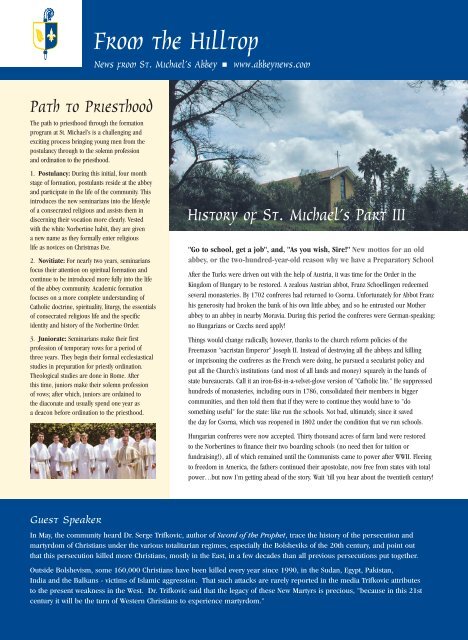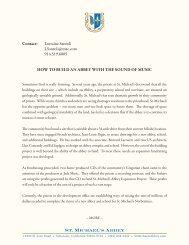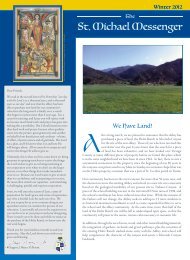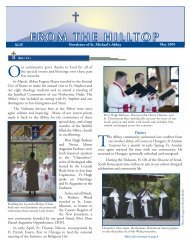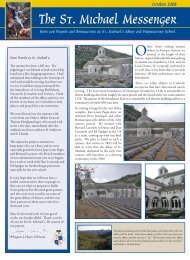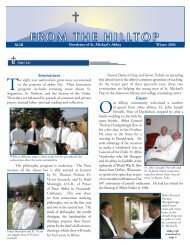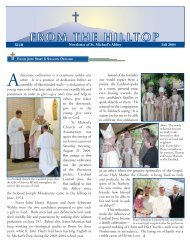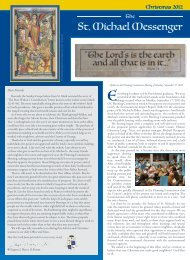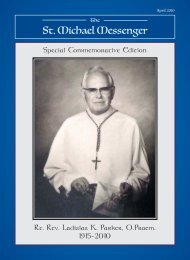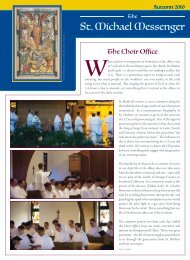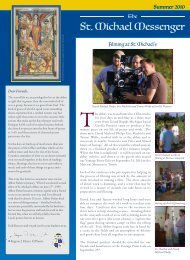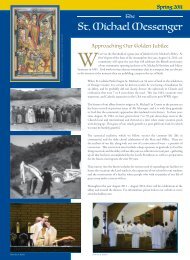July 2006 - St. Michael's Abbey
July 2006 - St. Michael's Abbey
July 2006 - St. Michael's Abbey
You also want an ePaper? Increase the reach of your titles
YUMPU automatically turns print PDFs into web optimized ePapers that Google loves.
From the Hilltop<br />
News from <strong>St</strong>. Michael’s <strong>Abbey</strong> ■<br />
www.abbeynews.com<br />
Path to Priesthood<br />
The path to priesthood through the formation<br />
program at <strong>St</strong>. Michael’s is a challenging and<br />
exciting process bringing young men from the<br />
postulancy through to the solemn profession<br />
and ordination to the priesthood.<br />
1. Postulancy: During this initial, four month<br />
stage of formation, postulants reside at the abbey<br />
and participate in the life of the community. This<br />
introduces the new seminarians into the lifestyle<br />
of a consecrated religious and assists them in<br />
discerning their vocation more clearly. Vested<br />
with the white Norbertine habit, they are given<br />
a new name as they formally enter religious<br />
life as novices on Christmas Eve.<br />
2. Novitiate: For nearly two years, seminarians<br />
focus their attention on spiritual formation and<br />
continue to be introduced more fully into the life<br />
of the abbey community. Academic formation<br />
focuses on a more complete understanding of<br />
Catholic doctrine, spirituality, liturgy, the essentials<br />
of consecrated religious life and the specific<br />
identity and history of the Norbertine Order.<br />
3. Juniorate: Seminarians make their first<br />
profession of temporary vows for a period of<br />
three years. They begin their formal ecclesiastical<br />
studies in preparation for priestly ordination.<br />
Theological studies are done in Rome. After<br />
this time, juniors make their solemn profession<br />
of vows; after which, juniors are ordained to<br />
the diaconate and usually spend one year as<br />
a deacon before ordination to the priesthood.<br />
History of <strong>St</strong>. Michael’s Part III<br />
"Go to school, get a job", and, "As you wish, Sire!" New mottos for an old<br />
abbey, or the two-hundred-year-old reason why we have a Preparatory School<br />
After the Turks were driven out with the help of Austria, it was time for the Order in the<br />
Kingdom of Hungary to be restored. A zealous Austrian abbot, Franz Schoellingen redeemed<br />
several monasteries. By 1702 confreres had returned to Csorna. Unfortunately for Abbot Franz<br />
his generosity had broken the bank of his own little abbey, and so he entrusted our Mother<br />
abbey to an abbey in nearby Moravia. During this period the confreres were German-speaking:<br />
no Hungarians or Czechs need apply!<br />
Things would change radically, however, thanks to the church reform policies of the<br />
Freemason "sacristan Emperor" Joseph II. Instead of destroying all the abbeys and killing<br />
or imprisoning the confreres as the French were doing, he pursued a secularist policy and<br />
put all the Church’s institutions (and most of all lands and money) squarely in the hands of<br />
state bureaucrats. Call it an iron-fist-in-a-velvet-glove version of "Catholic lite." He suppressed<br />
hundreds of monasteries, including ours in 1786, consolidated their members in bigger<br />
communities, and then told them that if they were to continue they would have to "do<br />
something useful" for the state: like run the schools. Not bad, ultimately, since it saved<br />
the day for Csorna, which was reopened in 1802 under the condition that we run schools.<br />
Hungarian confreres were now accepted. Thirty thousand acres of farm land were restored<br />
to the Norbertines to finance their two boarding schools (no need then for tuition or<br />
fundraising!), all of which remained until the Communists came to power after WWII. Fleeing<br />
to freedom in America, the fathers continued their apostolate, now free from states with total<br />
power…but now I’m getting ahead of the story. Wait ’till you hear about the twentieth century!<br />
Guest Speaker<br />
In May, the community heard Dr. Serge Trifkovic, author of Sword of the Prophet, trace the history of the persecution and<br />
martyrdom of Christians under the various totalitarian regimes, especially the Bolsheviks of the 20th century, and point out<br />
that this persecution killed more Christians, mostly in the East, in a few decades than all previous persecutions put together.<br />
Outside Bolshevism, some 160,000 Christians have been killed every year since 1990, in the Sudan, Egypt, Pakistan,<br />
India and the Balkans - victims of Islamic aggression. That such attacks are rarely reported in the media Trifkovic attributes<br />
to the present weakness in the West. Dr. Trifkovic said that the legacy of these New Martyrs is precious, "because in this 21st<br />
century it will be the turn of Western Christians to experience martyrdom."


